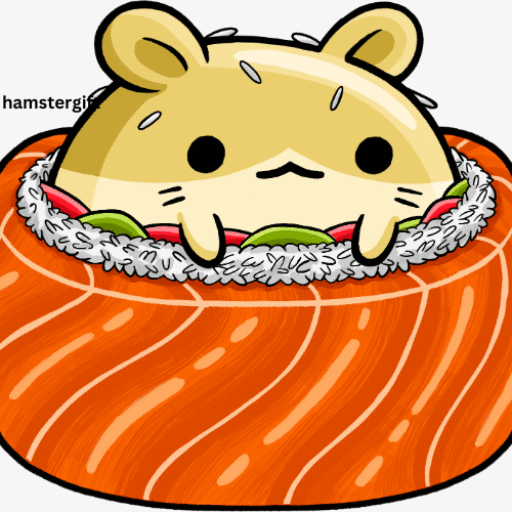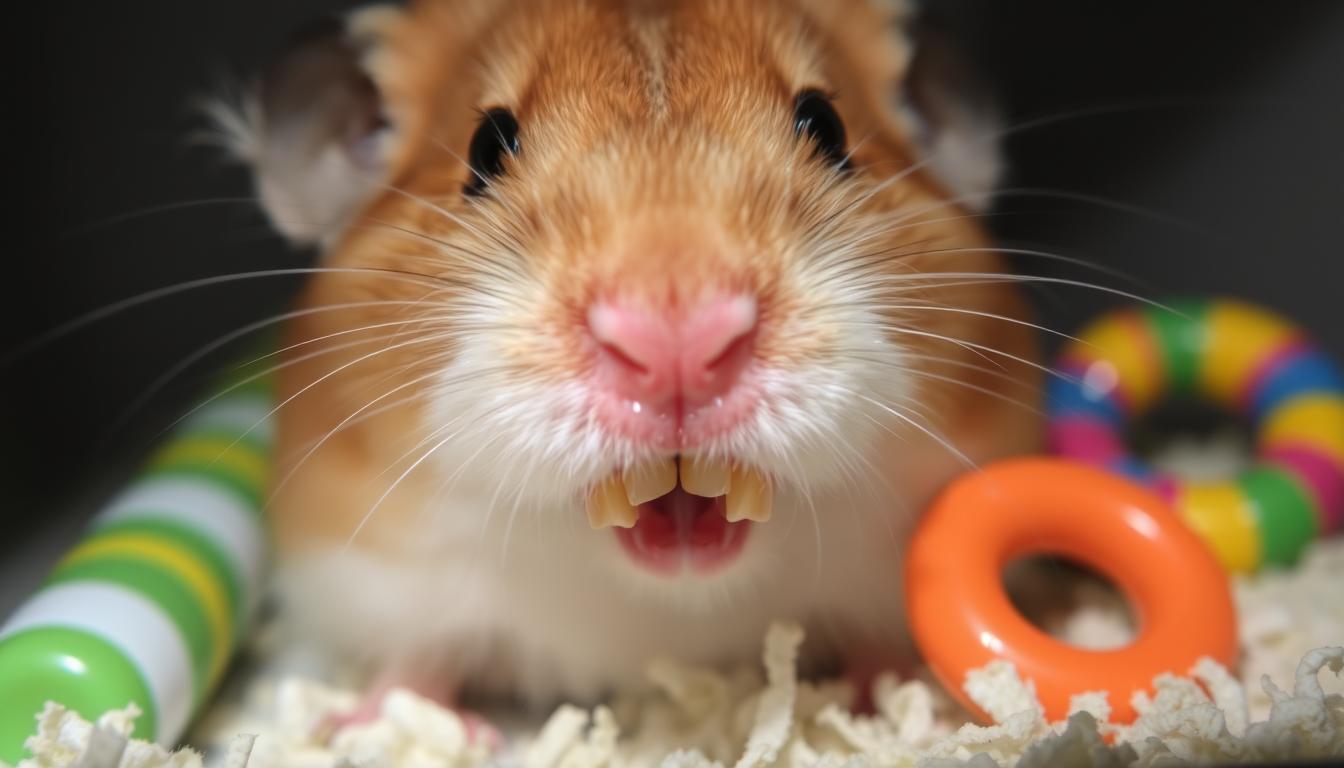Hamsters, those adorable little balls of fluff, are known for many things: their cheek pouches, their nocturnal antics, and their endless energy on the wheel. But did you know that their teeth are constantly growing? Unlike ours, hamster teeth don’t stop growing. This means that keeping them at the right length is crucial for their health and happiness. But how long is too long? And what can you do to prevent your furry friend from developing dental problems? Let’s dive into the world of hamster teeth and learn everything you need to know to keep your little companion smiling (or at least, not struggling to eat!).
Hamster Teeth: A Never-Ending Story of Growth!
Hamster teeth are truly remarkable. They’re not just for looks; they’re essential tools for a hamster’s survival. Unlike human teeth, which stop growing once we reach adulthood, hamster teeth are constantly erupting from the gums. This continuous growth is necessary because their natural diet in the wild consists of tough seeds, nuts, and roots that wear down their teeth significantly.
The upper incisors can grow at an astonishing rate, sometimes as much as 0.1 millimeters per day! The lower incisors grow slightly faster. This rapid growth highlights the importance of providing your hamster with the right environment and diet to keep those chompers in check. Without proper wear, the teeth can quickly become overgrown, leading to a host of problems.
Imagine if your fingernails never stopped growing! You’d need to constantly trim them to function properly. It’s the same with hamster teeth. They need to be worn down naturally through chewing. This is why understanding their dental needs is so vital for responsible hamster ownership.
The incisors, the front teeth, are the ones that cause the most concern when it comes to overgrowth. These are the teeth they use to gnaw and break down food. The molars, located further back in the mouth, also grow continuously, but they are less prone to overgrowth issues because they are naturally worn down by grinding food.
So, the next time you see your hamster happily munching away, remember that they’re not just enjoying a tasty treat; they’re also keeping their teeth healthy and properly sized. It’s a constant, natural process that requires our attention and support.
Understanding this never-ending growth cycle is the first step in ensuring your hamster enjoys a long, healthy, and happy life, free from the discomfort and complications of overgrown teeth.
The Perfect Length: What’s "Just Right" for Hamsters?
Determining the "perfect" length for hamster teeth can be a bit tricky, but there are some general guidelines to follow. Ideally, the incisors should be relatively short and straight, allowing the hamster to comfortably close its mouth. The upper incisors should be slightly shorter than the lower ones.
A good rule of thumb is that the upper incisors should be no longer than 2-3 millimeters extending beyond the lower lip. The lower incisors should be slightly longer, perhaps 3-4 millimeters beyond the upper lip. These measurements are approximate, but they provide a good visual reference.
It’s also important to observe the angle of the teeth. They should meet evenly, allowing for efficient gnawing. If the teeth are misaligned or growing at an odd angle, it could indicate a problem that needs veterinary attention.
The best way to gauge the correct length is to observe your hamster eating. If they can easily pick up and manipulate food, and if they’re chewing normally without any signs of discomfort, their teeth are likely at a healthy length.
However, if you notice your hamster struggling to eat, dropping food, or showing a preference for soft foods, it could be a sign that their teeth are too long or misaligned. These are crucial clues that something might be amiss.
Regularly checking your hamster’s teeth is a good habit to develop. Gently lift their lip to get a clear view of their incisors. This will help you spot any changes or potential problems early on, allowing you to take prompt action and prevent more serious complications.
Signs of Overgrown Teeth: Spotting Trouble Early On!
Recognizing the signs of overgrown teeth is crucial for early intervention. The sooner you identify a problem, the easier it will be to address and prevent further complications. Keep a close eye on your hamster’s eating habits and overall behavior.
One of the most obvious signs is difficulty eating. You might notice your hamster struggling to pick up food, dropping pieces frequently, or taking an unusually long time to chew. They may also show a preference for soft foods over hard ones.
Weight loss can also be a telltale sign. If your hamster is having trouble eating due to overgrown teeth, they may not be getting enough nutrients, leading to a gradual decline in weight. Regular weigh-ins can help you track any changes.
Another sign to watch out for is excessive drooling. Overgrown teeth can irritate the mouth and make it difficult for your hamster to swallow properly, resulting in increased saliva production.
You might also notice changes in your hamster’s grooming habits. They may neglect to groom themselves properly due to discomfort, leading to a matted or unkempt appearance.
In severe cases, overgrown teeth can even cause sores or abscesses in the mouth. These can be painful and require immediate veterinary attention. Look for any signs of swelling, redness, or discharge around the mouth.
Finally, listen for any unusual noises while your hamster is eating. Clicking or grinding sounds could indicate that their teeth are not aligned properly and are rubbing against each other.
Ouch! How Overgrown Teeth Affect Your Hamster’s Life
Overgrown teeth can significantly impact a hamster’s quality of life, causing discomfort, pain, and a range of health problems. It’s not just about difficulty eating; the consequences can be far-reaching.
The most immediate effect is difficulty in obtaining proper nutrition. If a hamster can’t chew properly, they won’t be able to eat enough to maintain their weight and energy levels. This can lead to weakness, lethargy, and a compromised immune system.
The constant discomfort can also affect their behavior. A hamster with overgrown teeth may become irritable, withdrawn, and less interested in playing or interacting with their owners. They might also exhibit signs of stress, such as excessive grooming or hiding.
In severe cases, overgrown teeth can lead to more serious complications, such as mouth sores, abscesses, and infections. These can be extremely painful and require prompt veterinary treatment. Untreated infections can even spread to other parts of the body, posing a serious threat to your hamster’s health.
Overgrown teeth can also interfere with a hamster’s ability to groom themselves properly. This can lead to matted fur, skin irritation, and an increased risk of skin infections.
The stress and discomfort associated with overgrown teeth can also weaken a hamster’s immune system, making them more susceptible to other illnesses. A weakened immune system can make it harder for them to fight off infections and recover from injuries.
Ultimately, overgrown teeth can significantly shorten a hamster’s lifespan. The chronic pain, malnutrition, and increased risk of infection can take a toll on their overall health and well-being. Therefore, preventing and addressing dental problems is essential for ensuring your hamster enjoys a long and happy life.
Diet Disasters: Food That Fails to File Those Teeth
A hamster’s diet plays a crucial role in maintaining healthy teeth. Not all foods are created equal when it comes to dental wear. Some foods are too soft and don’t provide enough abrasion to keep the teeth filed down naturally.
Diets that are primarily composed of soft pellets or processed foods can be detrimental to dental health. These foods are often easy to chew and swallow, requiring minimal effort and providing little to no wear on the teeth.
Foods high in sugar can also contribute to dental problems. Sugar can promote the growth of bacteria in the mouth, leading to tooth decay and other oral infections. Avoid giving your hamster sugary treats or foods with added sweeteners.
A lack of variety in the diet can also be a problem. If your hamster is only eating one type of food, they may not be getting the necessary nutrients to support healthy teeth and gums. A balanced diet is essential for overall health and dental well-being.
Certain types of nuts and seeds can be too small or too easily swallowed whole, providing little chewing action. Opt for larger, harder nuts and seeds that require more effort to crack open and eat.
Avoid giving your hamster sticky or gummy foods, as these can get stuck in their teeth and promote the growth of bacteria. These foods can also be difficult to remove and may require veterinary intervention.
Chew Toys to the Rescue: A Hamster’s Dental Dream
Chew toys are essential for maintaining a hamster’s dental health. They provide a safe and effective way for hamsters to wear down their teeth naturally, preventing overgrowth and related problems.
There are many different types of chew toys available, so it’s important to choose ones that are safe and appropriate for your hamster. Avoid toys made of soft plastic or materials that can be easily ingested, as these can pose a choking hazard.
Wooden chew toys are a popular and effective option. Look for untreated wood, such as applewood or willow, which is safe for hamsters to gnaw on. Avoid wood that has been treated with chemicals or paints, as these can be toxic.
Cardboard tubes and boxes can also provide hours of chewing entertainment. Make sure the cardboard is plain and free of any inks, dyes, or adhesives. You can also stuff the tubes with hay or shredded paper to encourage foraging and chewing.
Mineral blocks are another good option for providing dental wear. These blocks are made of compressed minerals that are safe for hamsters to chew on. They also provide essential nutrients that can contribute to overall health

